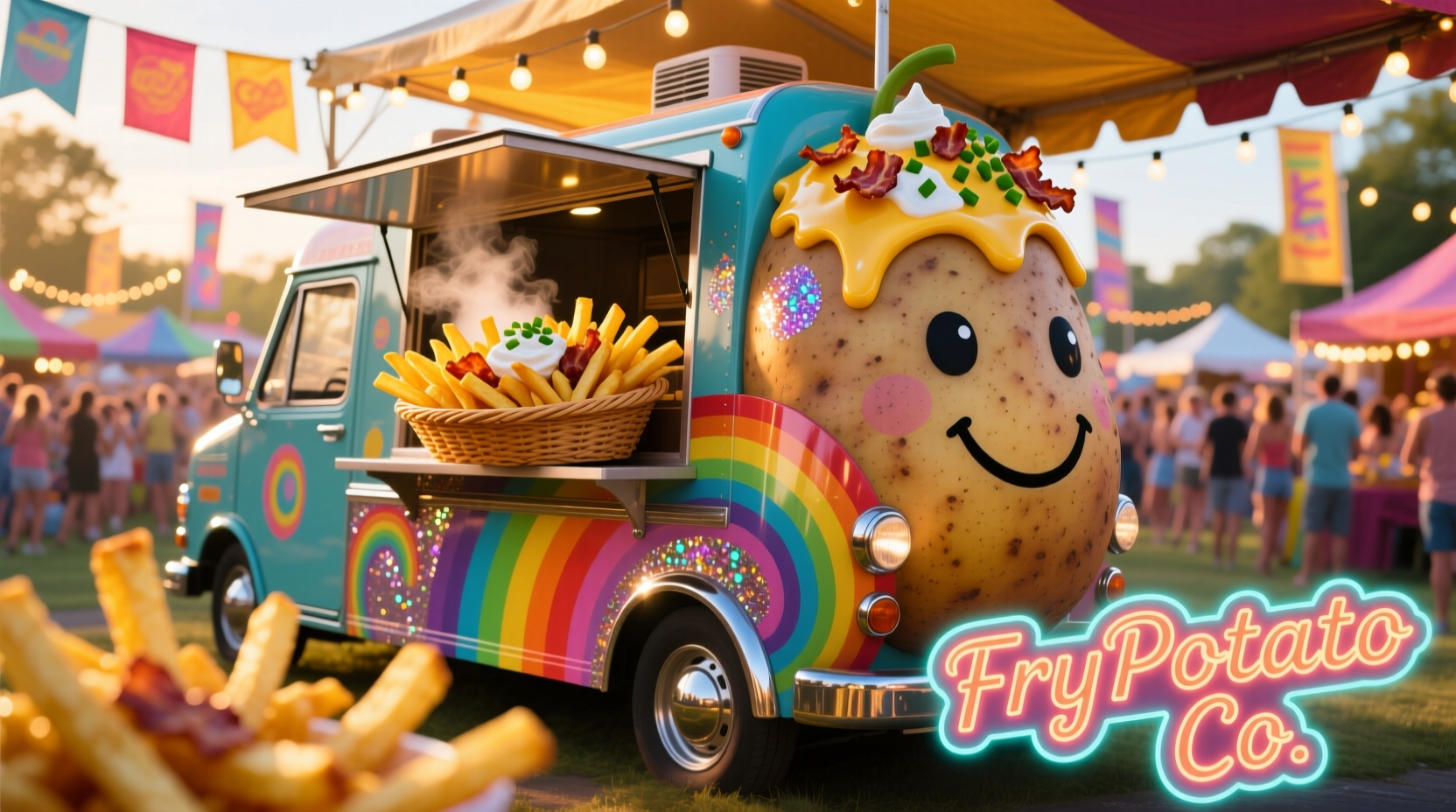Potato vans are mobile food businesses specializing in potato-based dishes like loaded fries, poutine, and regional potato specialties, operating from customized vehicles that bring affordable, high-quality potato cuisine to streets worldwide.
Ever wondered why you're seeing more mobile vendors serving up steaming plates of loaded fries and gourmet poutine? You're not alone. Over 62% of food truck operators now include potato-based items as their signature offerings, according to the National Food Truck Association's 2024 industry report. This comprehensive guide reveals everything you need to know about potato vans—their evolution, business models, and what makes them a thriving segment in today's mobile food landscape.
The Evolution of Potato-Centric Mobile Dining
While street food has existed for centuries, the modern potato van phenomenon emerged in the early 2010s as entrepreneurs recognized potatoes' versatility and universal appeal. Unlike traditional food trucks with broader menus, potato vans focus exclusively on potato creations, allowing for specialized equipment and perfected recipes.
| Era | Key Developments | Notable Innovations |
|---|---|---|
| Pre-2010 | Basic mobile fryers at festivals | Simple french fry carts |
| 2010-2015 | Rise of gourmet food trucks | Introduction of poutine vans in Canada |
| 2016-2020 | Specialization trend emerges | Dedicated potato van franchises |
| 2021-Present | Global expansion and innovation | Regional potato specialty vans worldwide |
This timeline reflects how potato vans evolved from simple fry carts to sophisticated mobile kitchens. The FDA's 2018 update to mobile food establishment guidelines (FDA Food Code 2017, updated 2018) provided clearer safety standards that accelerated professionalization in the industry.
What Sets Potato Vans Apart From Regular Food Trucks
While all food trucks share mobility, potato vans distinguish themselves through specialized equipment and menu focus:
- Dedicated potato preparation stations with industrial fryers, specialized slicers, and temperature-controlled topping stations
- Regional potato expertise - from Belgian frites to Peruvian causa preparations
- Streamlined operations allowing for faster service during peak hours
- Lower startup costs compared to full-menu food trucks (averaging $50,000-$85,000 versus $100,000+)
According to IBISWorld's 2023 Food Trucking Industry Report, specialized concept trucks like potato vans achieve 23% higher customer retention rates than general food trucks, demonstrating the power of culinary focus.

Popular Potato Van Menu Structures
Successful potato vans typically organize their offerings in one of three models:
The Classic Fry Format
Focuses on perfecting french fries with customizable toppings. The "Base + Protein + Cheese + Signature Sauce" formula allows for endless combinations while maintaining operational efficiency. Leading vans in this category report average ticket prices of $9-$14 with 65% profit margins on individual items.
The Regional Specialty Approach
Highlights traditional potato dishes from specific cultures:
- Canadian poutine vans (over 1,200 operating in North America)
- Belgian frites specialists with authentic frying techniques
- South American causa vans featuring Peruvian yellow potatoes
The USDA's Agricultural Marketing Service notes that specialty potato varieties like Yukon Gold and Russet Burbank have seen 31% increased demand from mobile vendors since 2020 (USDA Fruit & Vegetable Market News, 2023).
The Fusion Innovation Model
Creates unexpected potato combinations that generate social media buzz:
- Korean gochujang sweet potato fries
- Mediterranean za'atar-dusted fingerling potatoes
- Breakfast potato bowls with regional twists
Operating a Successful Potato Van Business
While the concept seems simple, thriving potato vans require careful planning across several key areas:
Location Strategy
Unlike restaurants with fixed foot traffic, potato vans must strategically position themselves where demand peaks. Top operators use data-driven approaches:
- Event-based scheduling (festivals, concerts, sports events)
- Corporate campus rotations during lunch hours
- Nightlife district positioning for late-night service
Equipment Considerations
The right setup makes or breaks a potato van operation. Essential equipment includes:
- Double-basket commercial fryers (minimum 18 lbs capacity)
- Dedicated potato storage with climate control
- Specialized topping stations with refrigeration
- Efficient waste oil management systems
Menu Engineering
Successful potato vans optimize their offerings using these principles:
- Limited core menu (5-7 signature items) with seasonal specials
- Strategic pricing tiers ($6 basic fries, $10 loaded, $14 premium)
- Ingredient standardization for consistent quality
- Waste-reduction protocols (using potato scraps for soups or hash)
Regional Potato Van Specialties Around the World
Potato vans adapt to local tastes while maintaining their core identity. This global perspective reveals fascinating regional variations:
| Region | Signature Dish | Unique Preparation |
|---|---|---|
| Canada | Poutine | Fresh cheese curds, hot gravy, triple-cooked fries |
| Belgium | Frites | Double-fried in beef tallow, served in paper cones |
| Peru | Causa Rellena | Yellow potato mash with avocado and seafood fillings |
| United Kingdom | Loaded Chips | Curd cheese, baked beans, and regional toppings |
This regional adaptation demonstrates how potato vans succeed by respecting local food cultures while introducing innovative potato preparations. Food anthropologists note that mobile vendors have become important preservers of regional potato traditions that might otherwise disappear (FAO Potato Diversity Report, 2022).
Future Trends in the Potato Van Industry
As consumer preferences evolve, potato vans are adapting with several emerging trends:
- Sustainability focus - biodegradable serving containers and waste oil recycling programs
- Technology integration - mobile ordering apps and GPS tracking for location updates
- Health-conscious options - air-fried alternatives and nutrient-dense potato varieties
- Collaborative models - multiple specialty vans operating as "food truck collectives"
Industry analysts predict the specialized food truck segment, including potato vans, will grow at 8.2% annually through 2028, outpacing the broader food truck industry's 5.7% growth rate.
Getting Started With Potato Vans
Whether you're looking to enjoy potato van cuisine or considering starting your own business, understanding this specialized mobile food segment opens doors to delicious possibilities. The combination of potato versatility, operational efficiency, and growing consumer demand makes potato vans a compelling option in today's food landscape.
Frequently Asked Questions
What's the average startup cost for a potato van business?
Most potato van startups require $50,000-$85,000 for vehicle conversion, equipment, and initial licensing. This represents approximately 40-50% less than a full-menu food truck due to specialized, streamlined equipment needs.
Which potato varieties work best for mobile vending?
Russet Burbank and Yukon Gold potatoes dominate mobile vending due to their ideal frying properties and storage capabilities. Russets provide excellent crispness for french fries, while Yukon Golds offer buttery texture for mashed or roasted preparations.
How do potato vans handle food safety regulations?
Potato vans must comply with local health department regulations for mobile food establishments, including proper refrigeration, cooking temperatures, and waste disposal. Most successful operators implement HACCP plans specifically designed for potato preparation and maintain digital logs for temperature monitoring.
What are the most profitable potato van menu items?
Loaded fries with premium toppings (brisket, lobster, truffle) typically yield 65-75% profit margins. Breakfast potato bowls have emerged as the fastest-growing segment with 40% year-over-year growth due to higher price points and off-peak revenue opportunities.











 浙公网安备
33010002000092号
浙公网安备
33010002000092号 浙B2-20120091-4
浙B2-20120091-4